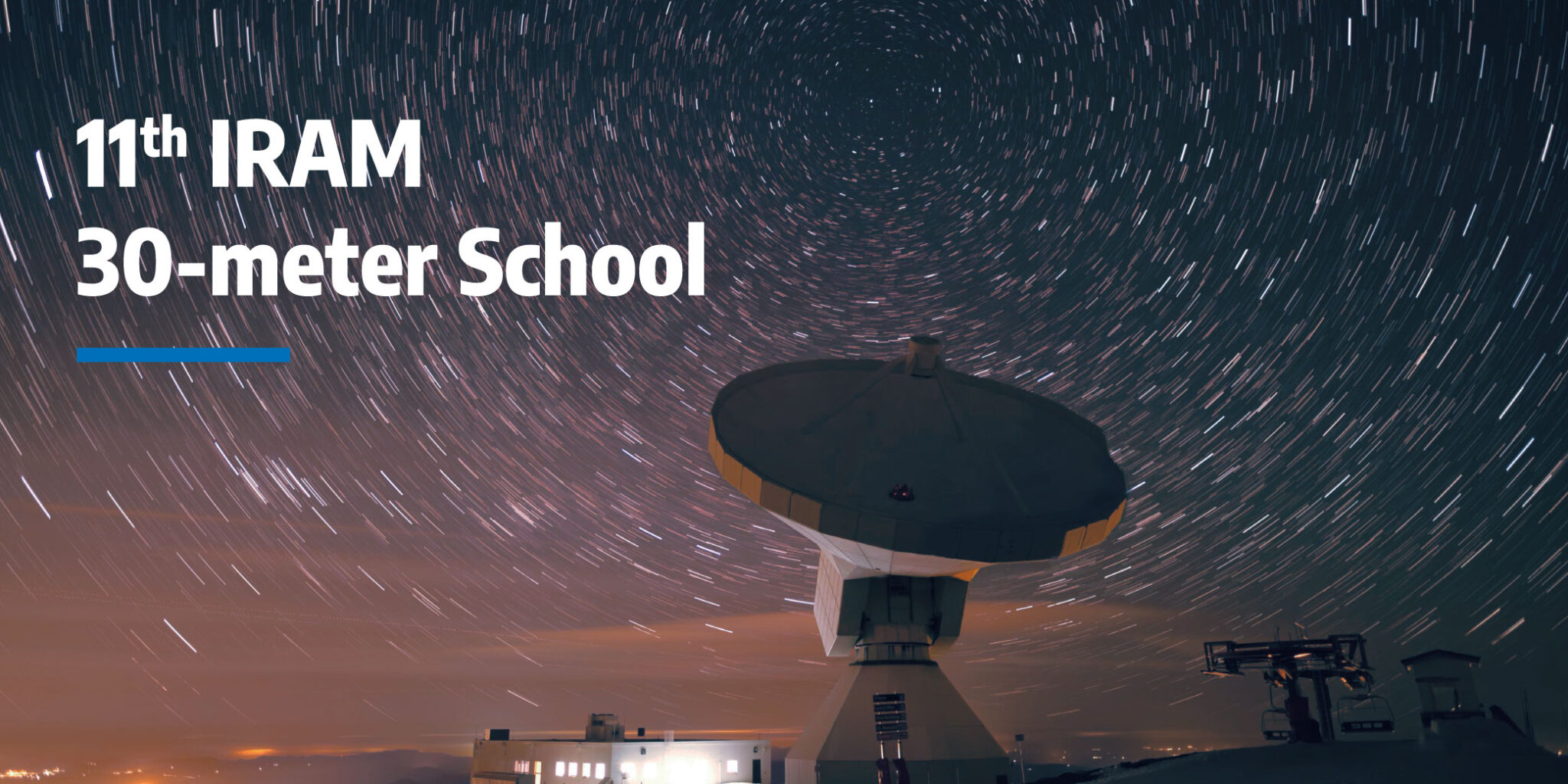News

New CARTA version 5.0 release
The current version 5.0-stable was released on 29th of July 2025.
Few interesting upgraded/new features include:
-
the copy function in the cursor info widget
-
channel map view (raster only)
- PV generator with a polyline region
Download new version on CARTA websites:
https://cartavis.org/
The 2nd European ALMA school on the 26.- 30.01.2026 in Leiden, Netherlands 
The 2nd ALMA school hosted by the Allegro ARC node and organised by the European ALMA Regional Centre network will be held at Leiden Observatory in Leiden in the Netherlands, from 26.01.2026 to 30.01.2026.
Aimed at PhD students and postdocs, the school will cover a broad range of aspects related to ALMA: interferometry, data calibration, synthesis imaging, exploiting the ALMA archive, analysis techniques, and future ALMA developments.
Registration will be on the first-come first-serve basis, with a total capacity of 70 participants, and a small registration fee (EUR 75).
Registration is opened now! - from 1 August to 31 October.
See details here.
The 11th IRAM 30m school 2025 on the 31.10 - 07.11.2025 in Granada, Spain
Great oportunity to learn more about millimetre astronomy with lectures covering wide range of scientific topics, instrumentation and data processesing. Lecturers and technical assistants prepared for participants unique hands-on exprience with IRAM 30m telescope observations covering the whole process from preparing a science case, conducting the observations, reducing the data, and presenting the first results on the last day of the school.
Deadline for registration is on August 15, 2025!
Please register at their webpage:
https://iram-institute.org/science-portal/events/30m-school/year-2025/
I-TRAIN with the European ARC Network: New Youtube Videos
The 'I-TRAIN' stands for 'Interactive Training in Reduction and Analysis of INterferometric data' and it is a regular series of training/hands-on sessions to cover a wide range of topics of interest to the ALMA user community with the aim to help users gain expertise in working with interferometric data.
In the months of May & June 2025, we had two new interesting I-TRAIN sessions!
- I-TRAIN #24: VLBI Part II: obtaining and calibrating VLBI data with phased ALMA by Micheal Janssen, Georgios-Filippos Paraschos, and Kazi Rygl - provides an introduction to accessing and dealing with VLBI data from Global Millimeter VLBI Array (GMVA) and EHT networks which include ALMA as a phased array.
 Presentation was uploaded to Youtube: https://www.youtube.com/watch?v=ml0xsqlcUaA
Presentation was uploaded to Youtube: https://www.youtube.com/watch?v=ml0xsqlcUaA
- VLBI Part I I-TRAIN is available here: https://www.youtube.com/watch?v=K6VmMnafI9s&t=2198s&pp=0gcJCccJAYcqIYzv - I-TRAIN #25: The ALMA UV coverage assessment tool (assess_ms 3.0) by Dirk Petry - provides an introduction to the first public release of the ALMA uv coverage assessment tool "assess_ms". It describes the installation and usage of the tool and explain the motivation and history of its development.
 Presentation was uploaded to Youtube: https://www.youtube.com/watch?v=VNY9znZgK28
Presentation was uploaded to Youtube: https://www.youtube.com/watch?v=VNY9znZgK28
You can find the videos of the past I-TRAIN sessions at the European ARC youtube channel and accompanying materials are accessible at the Science Portal I-TRAIN site (including slides, dataset and a compilation of most common questions and issues that arose during the live session).
Sixth EU ALMA Regional Centre Community Assembly
17 April 2023, 11:00 CET at this link.
The European ALMA Regional Centre invites European ALMA users to a virtual community assembly on April 17 at 11:00 CEST, in connection with the Cycle 10 call for proposals. At this meeting, we will provide more information on the procedures for Joint Proposals with other facilities, including the European Southern Observatory's Very Large Telescope, the Space Telescope Science Institute's James Webb Space Telescope, and the National Radio Astronomy Observatory's Karl G. Jansky Very Large Array.
We will furthermore update you on the new capabilities offered in Cycle 10, including ALMA Band 1, and on the support offered by the European ARC Network.

I-TRAIN with the European ARC Network
The European ARC Network is initiating I-TRAIN, a regular series of Interactive Training in Reduction and Analysis of INterferometric data. The sessions will cover a wide range of topics of interest to the ALMA user community with the aim to help users gain expertise in working with interferometric data. The duration of each training session will be about one hour, including a live demo and interactive Q&A.
You can find the video of the past I-TRAIN sessions at the European ARC youtube channel and accompanying materials are accessible at the Science Portal I-TRAIN site (including slides, dataset and a compilation of most common questions and issues that arose during the live session).
17 June 2022, 11:00 CET Zoom link
I-TRAIN #15: ALMA simulations with CASA
Description: In this training you will learn how to use CASA to produce simulated (mock) ALMA datasets in various formats, and for various array configurations (or combinations thereof). There are three levels at which this can be done: using the CASA tools directly (which requires relatively low-level programming), using CASA tasks (which only require input parameters), or using an online browser-based interface to these tasks which is build and designed by the UK ARC node: the OST. Several example input files and scripts will be used, as well as the online CASAguides examples made available by the CASA team.
The duration of this training session will be about one hour. If you have any doubts or questions, do not hesitate to contact the ESO ARC: evkampen@eso.org
ALMA Recounts of Cosmic Conundrums
The talks will be broadcasted through the Youtube channel of the European ALMA Regional Centre network
The European ARC network is launching the new virtual talk series "ALMA recounts of Cosmic Conundrums". In every talk of this series a major astronomical question is discussed. The invited speaker will describe the context of the question and then focuses on the ALMA contribution to the field, past and future. The aim of the series is to highlight the unparalleled contribution of ALMA to the broader astronomical landscape and to provide an outlook towards the future.
January 12, 2022 at 14:00 CET
The next talk will be by Eva Schinnerer (MPIA Heidelberg): What is the coupling between molecular clouds, star formation and stellar feedback?
Previous announcemenrts:
Fifth EU ALMA Regional Centre Community Assembly
24 March 2022, 11:00 CET at this link
The European ALMA Regional Centre invites all European ALMA users to the fifth virtual community assembly. At this community meeting, we will update you on Band 1, the ALMA GTO policies, the proposal review process and the Cycle 9 capabilities. We will also address all related questions at the Q&A session, right after the talks and will also answer any questions you may have on the support provided to European ALMA users from the European ARC network.

MAYA: Meeting of ALMA Young Astronomers - March 2-4, 2022
The European ALMA Regional Centre Network is happy to announce a new series of events targeted toward early career astronomers interested in ALMA: the Meeting for ALMA Young Astronomers (MAYA).
The first MAYA will take place on 2022 March 2nd to 4th and it will be fully on-line.
We encourage any undergraduate, PhD students and postdocs, either with a direct interest to ALMA or simple curiosity, to join the event and share their projects in an open and friendly atmosphere. All types of astronomical subjects and ALMA observing modes are welcome. The final program selection will incorporate diversity of topics and speakers. The goals of the meeting are to allow the participants to present their scientific work, interact with other participants and staff working in the ARC nodes, and potentially trigger new collaborations and new projects. The format will be 15 min live talks followed by 3 min questions. The event will be spread over 3 days, with two sessions of ~2h per day. We hope that this conference will create opportunities which will result in many exciting science proposals for the new Cycle 9 deadline to come.
Deadline for abstract submission is 2022 January 31st. The link for registration is here: Registration
Important dates:
- Registration deadline: 2022 January 31st
- Notifications of abstract selection: 2022 February 10th
- On-line event: 2022 March 2nd to 4th
SOC: Abhijeet Borkar (co-chair), Katharina Immer, Elisabetta Liuzzo (co-chair), Sebastien Muller (chair), Gergö Popping, Alvaro Sanchez-Monge
For any questions send an email to the soc: maya_soc@eso.org
I-TRAIN #10: Solar observations with ALMA
19 November 2021, 11:00 CET
[Zoom link]
Description: In this tutorial you will learn a specific procedures for calibration & imaging of solar ALMA data downloaded from the ALMA Science Archive. Attendees are kindly requested to download the training dataset and have CASA 5.6 installed (in case this CASA version is not available for attendees, alternatively they will be able to follow imaging steps without any issues with CASA 6.4).
The duration of this training session will be about one hour and will include an interactive Q&A session. For questions do not hesitate to contact the Czech node at barta@asu.cas.cz.
Note: The tutors' presentation will be recorded and an edited version of the recording will be posted in the Science Portal after the session. The interactive Q&A will not be recorded.
Materials:
- Tutorial Dataset (size: 20 Gb)
Tutor: Miroslav Bárta
I-TRAIN #5: Simulating ALMA Observations with the OST
11 March 2021, 11:00 CET
[Zoom link]
The European ARC Network is offering an online training on simulating observations with the ALMA Observation Support Tool (OST) on Thursday March 11, 2021, 11:00 CET [Zoom link]. The OST allows users to test the effect of differing array configurations, frequency tunings, pointing strategies and weather conditions on imaging (2D or 3D) a sky-model of their choosing. The output images can be used to support the scientific and technical justifications of their ALMA proposals or for comparing model data to existing ALMA observations. In this training session participants will learn how to work with the OST to ensure robust and meaningful ALMA simulations.
No specific preparations will be needed to follow this tutorial in full, the OST is available online at http://almaost.jb.man.ac.uk/. If attendees wish to simulate a sky-model of their favourite target these should be prepared in FITS format following the help documentation here (http://almaost.jb.man.ac.uk/help/#fitsinfo). Presentation slides will be shared in the Science Portal the day before the session.
The duration of this training session, hosted by the UK ARC node, will be about one hour and will include a live demo and an interactive Q&A session. For questions do not hesitate to contact the UK ARC node at alma-contact@jb.man.ac.uk (with subject OST I-TRAIN).
Note: The tutors' presentation will be recorded and an edited version of the recording will be posted in the Science Portal after the session. The interactive Q&A will not be recorded.
ALMA Regional Centre Community Assembly - December 18th, 11:00
The European ALMA Regional Centre invites all European ALMA users to a virtual community assembly on December 18 at 11:00 CET, following the pre-announcement for Cycle 8 2021, scheduled for December 17. At this community meeting, the ALMA director will present the latest on the Return to Operations. You will then be presented with the timeline for the Call for Proposals, the capabilities and changes in the reviewing process for Cycle 8 2021. Finally, you will have the opportunity to ask your questions on all the above in a dedicated Q&A session.
Reserve the date: 18 December at 11:00 CET. The meeting can be accessed at this link. Looking forward to seeing you then!
ALMA Regional Centre Community Assembly - October 8th, 10:00
The European ALMA Regional Centre invites all European ALMA users to a short virtual community assembly on October 8 at 10:00 CEST. After a long period of suspended science observing, there is now a path towards getting back on sky and collecting science data with ALMA again. At this community meeting, we will update you on the time line for recovery and can answer any questions you may have on your ALMA projects and support from the European ARC network.
Reserve the date: 8 October at 10:00 CEST. The meeting can be accessed at this link. Looking forward to seeing you then!
ALMA Cycle 7 Observations Suspended due to COVID-19!
March 20, 2020 - Due to the COVID-19 outbreak that has spread also to Chile, the ALMA Director has made the decision to suspend science operations with ALMA. This decision has been taken to protect the safety of ALMA staff, many of whom travel long distances by bus and by plane to reach the remote ALMA site in the Atacama Desert in northern Chile.
A reduced staff will be retained at the Operation Support Facility (OSF) to maintain the safety of the ALMA equipment and infrastructure. All other staff will be working remotely for the immediate future. The plan is to continue providing data processing, data archive services, and ARC support, including the Cycle 8 Call for Proposals while external conditions allow it.
An announcement will be posted when observations are resumed.
Social media
For the very latest updates from the European ALMA node teams, check out our Facebook, instagram and twitter feeds.
February 2020
What's worse than a black hole ? TWO black holes colliding !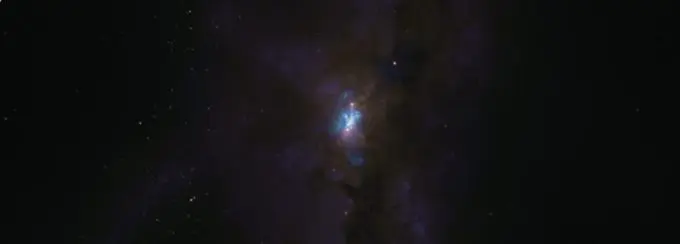 Galaxy merging is a violent and complex process at the best of time, but when the galaxies each also contain a supermassive black hole, it gets even worse. That's what happening in the case of NGC 6240, which ALMA has observed with a resolution ten times better than previous observations of the the molecular gas. The new data shows a structure quite different to the earlier results. Instead of the anticipated rotating discs, the team found, "a chaotic stream of gas with filaments and bubbles between the black holes. Some of this gas is ejected outwards with speeds up to 500 kilometers per second. We don’t know yet what causes these outflows." More...
Galaxy merging is a violent and complex process at the best of time, but when the galaxies each also contain a supermassive black hole, it gets even worse. That's what happening in the case of NGC 6240, which ALMA has observed with a resolution ten times better than previous observations of the the molecular gas. The new data shows a structure quite different to the earlier results. Instead of the anticipated rotating discs, the team found, "a chaotic stream of gas with filaments and bubbles between the black holes. Some of this gas is ejected outwards with speeds up to 500 kilometers per second. We don’t know yet what causes these outflows." More...
The oldest pollution in the Universe 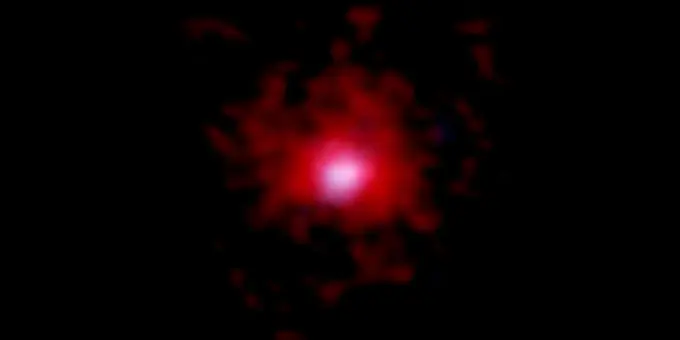 Even galaxies, on occasion, can become dark satanic mills, spewing out carbon at prodigious rates. While it's well-known that supernovae are responsible for most of the heavy elements in the Universe, no-one predicted the "diffuse but huge clouds floating in the coal-black Universe" that researchers have discovered with ALMA. The team combined archival observations to reach unprecedented sensitivity that would normally take 20 times longer than typical observations. This means that for the first time, astronomers can now study how such extragalactic pollution spreads through the Universe. More...
Even galaxies, on occasion, can become dark satanic mills, spewing out carbon at prodigious rates. While it's well-known that supernovae are responsible for most of the heavy elements in the Universe, no-one predicted the "diffuse but huge clouds floating in the coal-black Universe" that researchers have discovered with ALMA. The team combined archival observations to reach unprecedented sensitivity that would normally take 20 times longer than typical observations. This means that for the first time, astronomers can now study how such extragalactic pollution spreads through the Universe. More...
Discovering distant dust 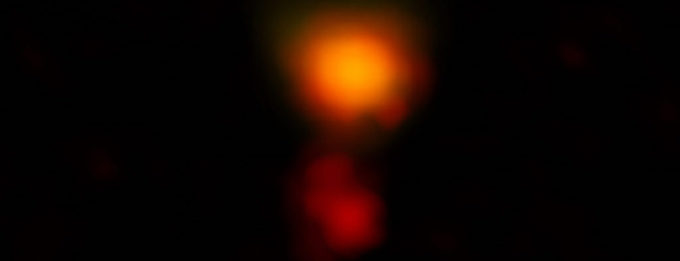 While galaxies like the Milky Way might form about one Sun-mass star per year, some of the most massive galaxies can form stars thousands of times faster. These star-forming factories are highly dust rich, making them great targets for ALMA given its frequency coverage. But such monsters are rare - to find them, we have to look back far enough to see the Universe when it was much younger. To detect anything at all at such outrageous distances often needs the help of a gravitational lens : an intervening galaxy that magnifies the more distant cosmos through its gravity. For the first time, ALMA has managed to see one of these distant star-forming galaxies without the help of such a lens. More...
While galaxies like the Milky Way might form about one Sun-mass star per year, some of the most massive galaxies can form stars thousands of times faster. These star-forming factories are highly dust rich, making them great targets for ALMA given its frequency coverage. But such monsters are rare - to find them, we have to look back far enough to see the Universe when it was much younger. To detect anything at all at such outrageous distances often needs the help of a gravitational lens : an intervening galaxy that magnifies the more distant cosmos through its gravity. For the first time, ALMA has managed to see one of these distant star-forming galaxies without the help of such a lens. More...
Attack of the violent peacocks 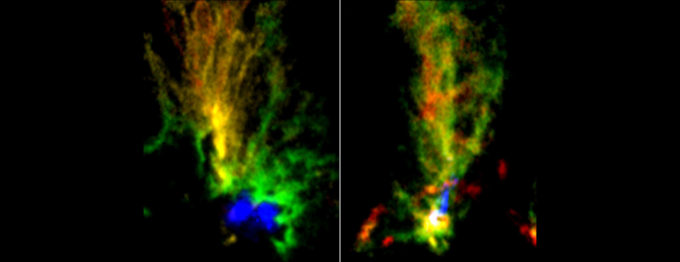 The Magellanic Clouds are two of the nearest dwarf satellite galaxies orbiting the Milky Way. At first glance they don't look like particularly violent places... until you start to examine their gas. ALMA has studied two spectacular clouds of dense, filamentary molecular gas, believed to be the birthplace of massive stars, both in the Large Magellanic Cloud. Unexpectedly, despite being 150 light years apart, the overall appearance of the clouds is remarkably similar. The researchers belive they may have a common origin as the two Magellanic Clouds are known to be interacting. If so, this is an important link in understanding how galaxy-scale processes affect the fromation of massive stars. More...
The Magellanic Clouds are two of the nearest dwarf satellite galaxies orbiting the Milky Way. At first glance they don't look like particularly violent places... until you start to examine their gas. ALMA has studied two spectacular clouds of dense, filamentary molecular gas, believed to be the birthplace of massive stars, both in the Large Magellanic Cloud. Unexpectedly, despite being 150 light years apart, the overall appearance of the clouds is remarkably similar. The researchers belive they may have a common origin as the two Magellanic Clouds are known to be interacting. If so, this is an important link in understanding how galaxy-scale processes affect the fromation of massive stars. More...
October 2019
Witness the power of this fully armed and operational planet formation... thing... in 3D !  For the first time, astronomers using the Atacama Large Millimeter/submillimeter Array (ALMA) have witnessed 3D motions of gas in a planet-forming disk. At three locations in the disk around a young star called HD 163296, gas is flowing like a waterfall into gaps that are most likely caused by planets in formation. These gas flows have long been predicted and would directly influence the chemical composition of planets atmospheres. This research appears in the latest issue of the journal Nature. “For the first time, we measured the motion of the gas in every possible direction. Rotating around, moving towards or away from the star, and up or downwards in the disk.” More...
For the first time, astronomers using the Atacama Large Millimeter/submillimeter Array (ALMA) have witnessed 3D motions of gas in a planet-forming disk. At three locations in the disk around a young star called HD 163296, gas is flowing like a waterfall into gaps that are most likely caused by planets in formation. These gas flows have long been predicted and would directly influence the chemical composition of planets atmospheres. This research appears in the latest issue of the journal Nature. “For the first time, we measured the motion of the gas in every possible direction. Rotating around, moving towards or away from the star, and up or downwards in the disk.” More...
How to ensure your black hole grows up big and strong : feed it counter-rotating material  Supermassive black holes already existed when the Universe was young, just a billion years after the Big Bang. But how these extreme objects, whose masses are up to billions of times the mass of the Sun, had time to grow so fast, is an outstanding question among astronomers. This new ALMA discovery could provide a clue. “Counter-rotating gas streams are unstable, which means that clouds fall into the black hole faster than they do in a disk with a single rotation direction,” said Impellizzeri. “This could be a way in which a black hole can grow rapidly.” More...
Supermassive black holes already existed when the Universe was young, just a billion years after the Big Bang. But how these extreme objects, whose masses are up to billions of times the mass of the Sun, had time to grow so fast, is an outstanding question among astronomers. This new ALMA discovery could provide a clue. “Counter-rotating gas streams are unstable, which means that clouds fall into the black hole faster than they do in a disk with a single rotation direction,” said Impellizzeri. “This could be a way in which a black hole can grow rapidly.” More...
August 2019
How do you weigh a black hole ? Very carefully ! 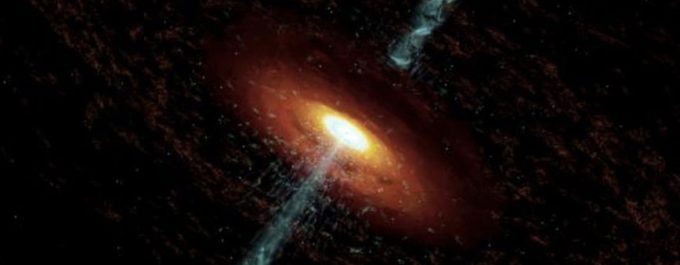 New observations with the Atacama Large Millimeter/submillimeter Array (ALMA) provide an unprecedented close-up view of a swirling disk of cold interstellar gas rotating around a supermassive black hole. This disk lies at the center of NGC 3258, a massive elliptical galaxy about 100 million light-years from Earth. Based on these observations, a team led by astronomers from Texas A&M University and the University of California, Irvine, have determined that this black hole weighs a staggering 2.25 billion solar masses, the most massive black hole measured with ALMA to date. Even accounting for the uncertain distance, this is one of the most highly precise mass measurements for any black hole outside of the Milky Way galaxy. More...
New observations with the Atacama Large Millimeter/submillimeter Array (ALMA) provide an unprecedented close-up view of a swirling disk of cold interstellar gas rotating around a supermassive black hole. This disk lies at the center of NGC 3258, a massive elliptical galaxy about 100 million light-years from Earth. Based on these observations, a team led by astronomers from Texas A&M University and the University of California, Irvine, have determined that this black hole weighs a staggering 2.25 billion solar masses, the most massive black hole measured with ALMA to date. Even accounting for the uncertain distance, this is one of the most highly precise mass measurements for any black hole outside of the Milky Way galaxy. More...
ALMA detects possible dark ancestors of elliptical galaxies  ALMA has identified 39 faint galaxies that are not seen with the Hubble Space Telescope’s most in-depth view of the Universe, 10 billion light-years away. They are ten times more numerous than similarly massive but optically–bright galaxies detected with Hubble. The research team assumes that these faint galaxies precede massive elliptical galaxies in the present Universe. However, no significant theories for the evolution of the Universe have predicted such an abundant population of star-forming, dark, massive galaxies. The new ALMA results throw into question our understanding of the early Universe. These results appear in the latest issue of the journal Nature. More....
ALMA has identified 39 faint galaxies that are not seen with the Hubble Space Telescope’s most in-depth view of the Universe, 10 billion light-years away. They are ten times more numerous than similarly massive but optically–bright galaxies detected with Hubble. The research team assumes that these faint galaxies precede massive elliptical galaxies in the present Universe. However, no significant theories for the evolution of the Universe have predicted such an abundant population of star-forming, dark, massive galaxies. The new ALMA results throw into question our understanding of the early Universe. These results appear in the latest issue of the journal Nature. More....
June 2019
First observations of a circumplanetary disc 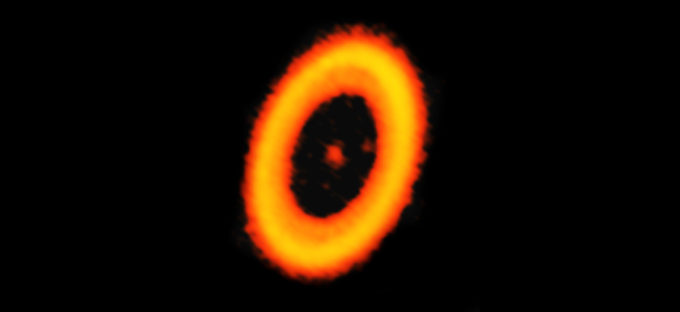 ALMA has made the first-ever observations of a circumplanetary disk, the planet-girding belt of dust and gas that astronomers believe controls the formation of planets and gives rise to an entire system of moons, like the one found around Jupiter. This young star system, PDS 70, is located approximately 370 light-years from Earth. The ALMA data, combined with the earlier optical and infrared VLT observations, provide compelling evidence that a dusty disk capable of forming multiple moons surrounds the outermost known planet in the system. “For the first time, we can conclusively see the telltale signs of a circumplanetary disk, which helps to support many of the current theories of planet formation,” said Andrea Isella, an astronomer at Rice University in Houston, Texas, and lead author on a paper published in the Astrophysical Journal Letters. More...
ALMA has made the first-ever observations of a circumplanetary disk, the planet-girding belt of dust and gas that astronomers believe controls the formation of planets and gives rise to an entire system of moons, like the one found around Jupiter. This young star system, PDS 70, is located approximately 370 light-years from Earth. The ALMA data, combined with the earlier optical and infrared VLT observations, provide compelling evidence that a dusty disk capable of forming multiple moons surrounds the outermost known planet in the system. “For the first time, we can conclusively see the telltale signs of a circumplanetary disk, which helps to support many of the current theories of planet formation,” said Andrea Isella, an astronomer at Rice University in Houston, Texas, and lead author on a paper published in the Astrophysical Journal Letters. More...
The earliest galaxy merger ever seen  Researchers using ALMA observed the earliest combined signals of oxygen, carbon, and dust from a galaxy in the Universe, 13 billion years ago. By comparing the different signals, the team determined that the galaxy B14-65666 is, in fact, two merging galaxies, making it the earliest example of merging galaxies yet discovered. The research team estimated that the total stellar mass of B14-65666 is less than 10% that of the Milky Way, meaning that it’s in its earliest phases of evolution. Despite its youth, B14-65666 is producing stars 100 times more actively than the Milky Way. Such active star-formation rate is another signature of galactic mergers because the gas compression in colliding galaxies naturally leads to bursty star-formation. More...
Researchers using ALMA observed the earliest combined signals of oxygen, carbon, and dust from a galaxy in the Universe, 13 billion years ago. By comparing the different signals, the team determined that the galaxy B14-65666 is, in fact, two merging galaxies, making it the earliest example of merging galaxies yet discovered. The research team estimated that the total stellar mass of B14-65666 is less than 10% that of the Milky Way, meaning that it’s in its earliest phases of evolution. Despite its youth, B14-65666 is producing stars 100 times more actively than the Milky Way. Such active star-formation rate is another signature of galactic mergers because the gas compression in colliding galaxies naturally leads to bursty star-formation. More...
April 2019
The first image of a black hole
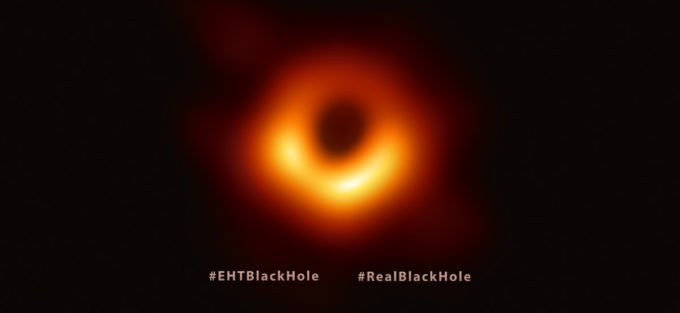 Event Horizon Telescope researchers reveal that they have succeeded, unveiling the first direct visual evidence of a supermassive black hole and its shadow. The image reveals the black hole at the center of Messier 87, a massive galaxy in the nearby Virgo galaxy cluster. This black hole resides 55 million light-years from Earth and has a mass 6.5-billion times that of the Sun.
Event Horizon Telescope researchers reveal that they have succeeded, unveiling the first direct visual evidence of a supermassive black hole and its shadow. The image reveals the black hole at the center of Messier 87, a massive galaxy in the nearby Virgo galaxy cluster. This black hole resides 55 million light-years from Earth and has a mass 6.5-billion times that of the Sun.
“ALMA is the largest millimeter wave telescope in the world and so was critical in the collaboration,” said ALMA Director Sean Dougherty; “It really helped to ensure high-quality calibration of the data to each of the other telescopes in the array, resulting in the fantastic images from the EHT.” More...
March 2019
A salty young star in Orion
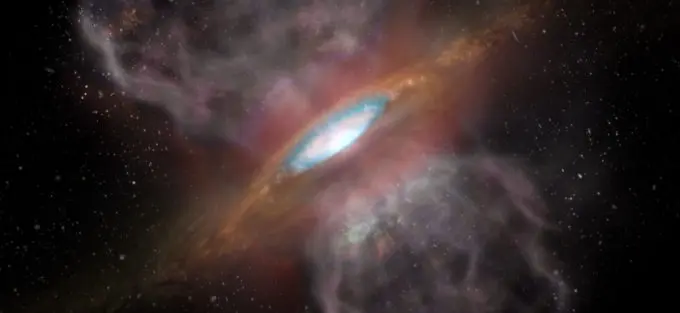 A team of astronomers and chemists using the Atacama Large Millimeter/submillimeter Array (ALMA) has detected the chemical fingerprints of sodium chloride (NaCl) and other similar salty compounds emanating from the dusty disk surrounding Orion Source I, a massive, young star in a dusty cloud behind the Orion Nebula. "When we look at the information ALMA has provided, we see about 60 different transitions - or unique fingerprints - of molecules like sodium chloride and potassium chloride coming from the disk. That is both shocking and exciting," said Brett McGuire, a chemist at the NRAO in Charlottesville, Virginia, and co-author on the paper. More...
A team of astronomers and chemists using the Atacama Large Millimeter/submillimeter Array (ALMA) has detected the chemical fingerprints of sodium chloride (NaCl) and other similar salty compounds emanating from the dusty disk surrounding Orion Source I, a massive, young star in a dusty cloud behind the Orion Nebula. "When we look at the information ALMA has provided, we see about 60 different transitions - or unique fingerprints - of molecules like sodium chloride and potassium chloride coming from the disk. That is both shocking and exciting," said Brett McGuire, a chemist at the NRAO in Charlottesville, Virginia, and co-author on the paper. More...
Organic molecules around a young star
 Astronomers using ALMA have detected various complex organic molecules around the young star V883 Ori. A sudden outburst from this star is releasing molecules from the icy compounds in the planet forming disk. The chemical composition of the disk is similar to that of comets in the modern Solar System. Sensitive ALMA observations enable astronomers to reconstruct the evolution of organic molecules from the birth of the Solar System to the objects we see today. More...
Astronomers using ALMA have detected various complex organic molecules around the young star V883 Ori. A sudden outburst from this star is releasing molecules from the icy compounds in the planet forming disk. The chemical composition of the disk is similar to that of comets in the modern Solar System. Sensitive ALMA observations enable astronomers to reconstruct the evolution of organic molecules from the birth of the Solar System to the objects we see today. More...
Studying 100,000 star factories in 74 galaxies
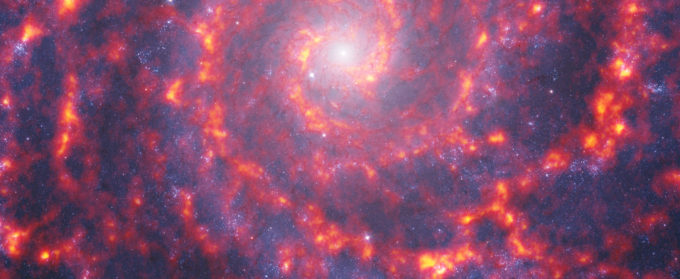 PHANGS-ALMA, an unprecedented and ongoing research campaign, is measuring a staggering 100,000 individual stellar nurseries spread throughout 74 galaxies. It has has already amassed a total of 750 hours of observations and given astronomers a much clearer understanding of how the cycle of star formation changes, depending on the size, age, and internal dynamics of each individual galaxy. This campaign is ten- to one-hundred-times more powerful (depending on your parameters) than any prior survey of its kind. More...
PHANGS-ALMA, an unprecedented and ongoing research campaign, is measuring a staggering 100,000 individual stellar nurseries spread throughout 74 galaxies. It has has already amassed a total of 750 hours of observations and given astronomers a much clearer understanding of how the cycle of star formation changes, depending on the size, age, and internal dynamics of each individual galaxy. This campaign is ten- to one-hundred-times more powerful (depending on your parameters) than any prior survey of its kind. More...
ALMA studies a new type of cosmic blast
 Astronomers have detected an explosion that's faster than known supernovae, and ALMA has revealed that it's brighter at millimetre wavelengths than other explosive events. The explosion was discovered by the ATLAS all-sky survey system in Hawaii, and immediately got the attention of astronomers. First, it was unusually bright for a supernova explosion - a common source of such outbursts. In addition, it brightened, then faded, much faster than expected. "If it is a supernova, then it is unlike any supernova we have ever seen," Ho said. The object's range of colors, or spectrum, she said, "doesn't t look like a supernova at all." In addition, it was brighter in millimeter waves - those seen by ALMA - than any other supernova. More...
Astronomers have detected an explosion that's faster than known supernovae, and ALMA has revealed that it's brighter at millimetre wavelengths than other explosive events. The explosion was discovered by the ATLAS all-sky survey system in Hawaii, and immediately got the attention of astronomers. First, it was unusually bright for a supernova explosion - a common source of such outbursts. In addition, it brightened, then faded, much faster than expected. "If it is a supernova, then it is unlike any supernova we have ever seen," Ho said. The object's range of colors, or spectrum, she said, "doesn't t look like a supernova at all." In addition, it was brighter in millimeter waves - those seen by ALMA - than any other supernova. More...
Older news
June 7, 2018
![]()
Vývoj režimu slunečních pozorování observatoře ALMA úspěšně dokončen
V aktuálně probíhajícím pozorovacím Cyklu 5 provádějí pracovníci výzkumné infrastruktury EU-ARC.CZ zpracování a kontrolu kvality dat z nedávného pozorování Slunce interferometrem ALMA. More...
May 23, 2018

ALMA Cycle 6 submission statistics available
In the Cycle 6, the demand for using the most advanced radio telescope in the world set a new record, surpassing 1800 proposals. A detailed report of the Cycle 6 Proposal Submission Statistics is now available. More...
May 15, 2018

ALMA Finds Most-Distant Oxygen in the Universe
Astronomers detected a faint but definite signal of oxygen in a galaxy located 13.28 billion light-years away from us, through observations using the Atacama Large Millimeter/submillimeter Array (ALMA). More...
May 3, 2018

ALMA Reaches 1000 Published Papers
The Atacama Large Millimeter/submillimeter Array (ALMA) has reached an important milestone with the publication of the 1000th peer-reviewed paper using ALMA data. More...
Vývoj režimu slunečních pozorování observatoře ALMA úspěšně dokončen
June 7, 2018
V aktuálně probíhajícím pozorovacím Cyklu 5 největšího astronomického přístroje současnosti – radiového interferometru ALMA – provádějí pracovníci výzkumné infrastruktury EU-ARC.CZ zpracování a kontrolu kvality dat z nedávného pozorování Slunce. Zredukovaná data zobrazená metodou interferometrické syntézy poté budou prostřednictvím centrály Evropského regionálního centra ALMA (EU ARC) se sídlem v ESO v Garchingu u Mnichova odeslána vedoucím jednotlivých pozorovacích projektů, kteří následně začnou s jejich vědeckou analýzou. Pozorování Slunce nabízí observatoř ALMA odborné veřejnosti teprve ve druhém pozorovacím cyklu. Na přípravě tohoto speciálního režimu pracoval několik let mezinárodní tým Solar ALMA Development Team složený ze zástupců ESO, severoamerické NRAO a japonské NAOJ. Výzkumná infrastruktura EU-ARC.CZ v něm jakožto jediný uzel evropské sítě ALMA s expertizou v oblasti slunečních radiových pozorování zastupovala celou Evropu. V roce 2015 také EU-ARC.CZ získala od ESO podporu v podobě projektu typu Enhancement and Optimization of (ALMA) Capabilities s názvem Solar Research with ALMA. Tento projekt byl úspěšně dokončen na konci loňského roku a celkový přínos evropského zastoupení pod vedením EU-ARC.CZ k vývoji slunečního pozorovacího režimu získal od oponentního panelu velice kladné hodnocení. Článek shrnující vývoj speciálního režimu, který umožnil observatoři ALMA pozorovat Slunce, vyšel v aktuálním vydání časopisu ESO The Messenger (číslo 171, 2018).
Celý článek vyšel na www.vyzkumne-infrastruktury.cz

ALMA Cycle 6 submission statistics available
May 23, 2018
In the Cycle 6, the demand for using the most advanced radio telescope in the world set a new record, surpassing 1800 proposals. A detailed report of the Cycle 6 Proposal Submission Statistics is now available. The report provides a summary of items such as the number of submitted proposals and time requested, subscription rates, and comparisons with the number of hours requested in previous Cycles. The new cycle begins in October this year and ends in September 2019. 4000 hours of the 12-m Array time and 3000 hours of the Atacama Compact Array (ACA) time, also known as the Morita Array, will be available for successful proposals. The science ranking process will take place in Tokyo, Japan, between June 18-23.
Number of Submitted Proposals and Time Requested:
Time requested (hours) |
||||
Number |
12-m |
7-m |
TP |
|
All proposals |
1838 | 19,696 | 10,941 | 7117 |
ACA standalone |
112 | - | 3672 | 1523 |
Large programs |
18 | 1830 | 1603 | 1315 |
Polarization |
101 | 1015 | - | - |
Solar |
32 | 124 | 124 | 124 |
ToO |
23 | 203 | 29 | 0 |
VLBI (3mm) |
9 | 69 | - | - |
VLBI (1mm) |
11 | 138 | - | - |
Subscription Rates:
Europe |
North America |
East Asia |
Chile |
All |
|
12-m array |
6.2 | 4.3 | 4.5 | 3.0 | 4.9 |
7-m array |
4.2 | 3.3 | 3.1 | 3.0 | 3.6 |
TP |
2.6 | 2.1 | 2.9 | 1.1 | 2.4 |
ALMA Finds Most-Distant Oxygen in the Universe
May 15, 2018
Source: http://www.almaobservatory.org
Astronomers detected a faint but definite signal of oxygen in a galaxy located 13.28 billion light-years away from us, through observations using the Atacama Large Millimeter/submillimeter Array (ALMA). Breaking their records, this marks the most distant oxygen ever detected in the Universe. Referencing infrared observations, the team determined that star formation in the galaxy started at an unexpectedly early stage: 250 million years after the Big Bang.
"I was thrilled to see the signal of the most distant oxygen,” explains Takuya Hashimoto, the lead author of the research paper published in the journal Nature and a researcher at Osaka Sangyo University and the National Astronomical Observatory of Japan.“This detection pushes back the frontiers of the observable Universe."

ALMA Reaches 1000 Published Papers
May 3, 2018
The Atacama Large Millimeter/submillimeter Array (ALMA) has reached an important milestone with the publication of the 1000th peer-reviewed paper using ALMA data. The paper was Spatial variations in Titan’s atmospheric temperature: ALMA and Cassini comparisons from 2012 to 2015 by Alexander E. Thelen et al. — which presents a detailed investigation of the atmospheric temperature of Saturn’s largest moon, Titan.
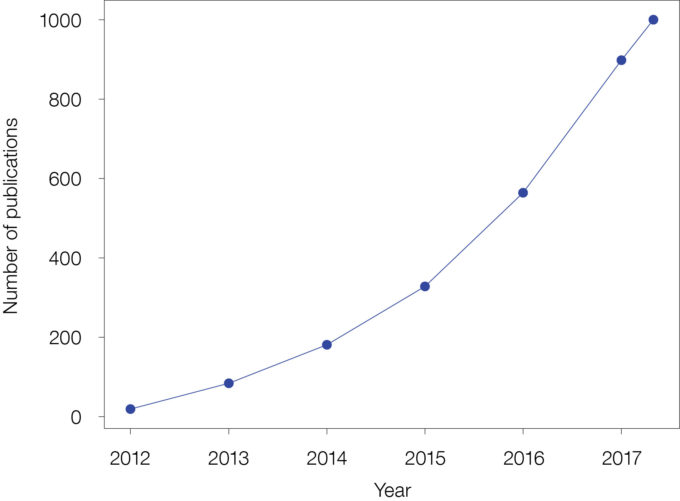
 The 1st European ALMA school was held by the UK ARC node in Manchester in 2024. For more details see the ALMA UK school websites here.
The 1st European ALMA school was held by the UK ARC node in Manchester in 2024. For more details see the ALMA UK school websites here.